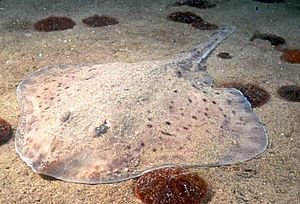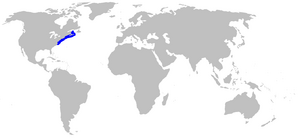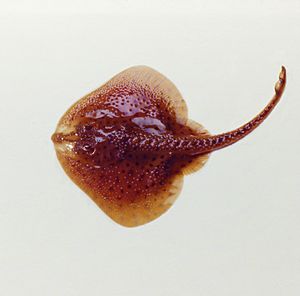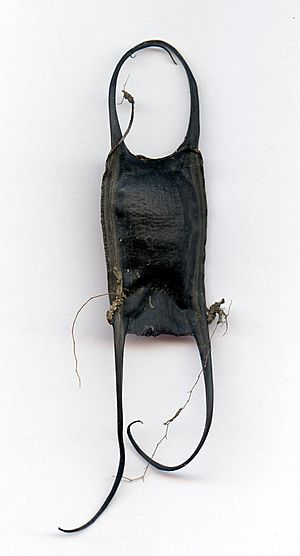Little skate facts for kids
Quick facts for kids Little skate |
|
|---|---|
 |
|
| Conservation status | |
| Scientific classification | |
 |
|
| Range of the little skate | |
| Synonyms | |
|
The little skate (Leucoraja erinacea) is a type of skate. It's a flat fish that lives on the ocean floor. You can find them along the Atlantic coast, from Nova Scotia, Canada, down to North Carolina, USA. They are very common in these areas. People sometimes use them as bait for lobster traps. Their "wings" can also be eaten. Scientists also study little skates to learn more about biology and medicine.
Contents
Where Little Skates Live
Little skates live in the western Atlantic Ocean. Their home stretches from Nova Scotia, Canada, to Cape Hatteras, North Carolina, USA. They are most common in areas like the northern Mid-Atlantic Bight and the Georges Bank.
These skates like to live on sandy or gravelly ocean floors. You can find them from the shore down to about 90 meters (295 feet) deep. Sometimes, they are caught much deeper, up to 329 meters (1,079 feet). Little skates can live in water temperatures from 1.2 to 21 degrees Celsius (34 to 70 degrees Fahrenheit). They also do well in salty water, preferring a saltiness of 29 to 33 parts per thousand.
Little skates do not travel very far. In shallow areas, they move closer to shore in summer. They go to deeper water in fall and winter. In the southern parts of their range, many skates move north and south as the water temperature changes.
What Little Skates Look Like
The little skate has a round body, which is called a "disk." This disk is about 1.2 times wider than it is long. They have a blunt snout (nose) with a small tip in the middle. Inside their jaws, they have 38 to 66 rows of round teeth. These teeth are good for grinding up their food.
Their pelvic fins are special. They are split into two parts. The front part looks a bit like a leg. The tail of a young skate is longer than its body. But in adult skates, the tail is shorter than the body. They have two small dorsal fins (back fins) close to the end of their tail.
Adult skates have small, rough scales on their skin. These are called dermal denticles. They usually do not have thorns down their back. However, they do have strong spines on their head, shoulders, and tail. Male skates usually have fewer spines than females.
Little skates can be grayish or different shades of brown on top. Their color gets lighter towards the edges of their body. Their underside is white or gray. Most little skates have small, dark, round spots on their back. Their tail might have dark blotches or be dark gray underneath.
It can be hard to tell a little skate apart from a winter skate (Leucoraja ocellata) if the winter skate doesn't have spots. Little skates are usually 41 to 51 centimeters (16 to 20 inches) long. Some can grow up to 54 centimeters (21 inches) long. Skates in the northern parts of their range tend to grow larger.
Little Skate Behavior and Life
Little skates are more active at night. During the day, they often bury themselves in the sand or gravel. They like to hide near special spots, like holes dug by other animals.
They have a unique way of moving along the ocean floor. Scientists call it "punting." The front parts of their pelvic fins are like little legs. These "legs" have three flexible joints. The skate pushes off the bottom with both "legs" and then glides a short distance. Then, they get ready for the next push. They also use these "legs" to turn. Scientists think this way of moving might help them hunt. It could reduce water movement that might scare away their prey.
The tail of the little skate has a special organ that creates a weak electric field. This electric field lasts for about 70 milliseconds. Scientists believe this electric organ helps skates communicate with each other. It might help male and female skates find each other for mating.
Young and adult little skates can be eaten by many animals. These include sharks, other skates, and many types of bony fish. Some fish that eat them are cod, goosefish, sea ravens, and bluefish. Gray seals and rock crabs also hunt them. Even their egg cases are eaten by sea urchins and whelks.
Little skates can also have parasites. These are tiny living things that live on or inside the skate. Some examples are tiny protozoans and worms.
What Little Skates Eat
Little skates mainly eat small crustaceans, like crabs and shrimp. They also eat polychaete worms, which are a type of sea worm. Sometimes, they eat other small sea creatures like isopods, clams, and small fish. As skates get bigger, they eat more crustaceans.
Little skates share their home with winter skates. But they eat different things. Little skates mostly eat animals that live on top of the sand. Winter skates eat more animals that burrow into the sand. Little skates have many special sensors around their mouth. These sensors help them find prey that is hidden in the sand.
Little Skate Life Cycle and Reproduction
Little skates lay eggs. This means they are oviparous. They mate throughout the year, and you can find pregnant females at any time. However, they lay most of their eggs from October to December and from April to May. They lay the fewest eggs in August, September, February, and March.
On average, a little skate lays eggs twice a year, in spring and fall. Each year, a female skate lays between 10 and 35 eggs. They lay their egg cases in pairs on sandy bottoms. The water is usually not deeper than 27 meters (89 feet).
When first laid, the egg cases are amber-colored. They soon turn greenish-brown and feel like leather. Each case is shaped like a rectangle and holds one fertilized egg. They are about 44 to 63 millimeters (1.7 to 2.5 inches) long and 30 to 45 millimeters (1.2 to 1.8 inches) wide.
Each corner of the egg case has a hollow horn. These horns have sticky parts that help the egg case attach to the ocean floor. The front horns are half as long as the case and curve inward. The back horns are as long as the case and are almost straight.
In aquariums, eggs hatch in 5 to 6 months. In the wild, it can take up to 12 months for eggs to hatch. This depends on the water temperature. While inside the case, the baby skate has a whip-like tail. This tail helps to move water around inside the case.
When they hatch, newborn skates are 93 to 102 millimeters (3.7 to 4 inches) long. They look just like tiny versions of adult skates. After the babies hatch, the empty egg cases often wash up on beaches. People sometimes call these "mermaid's purses."
Little skates grow about 10 centimeters (4 inches) each year for the first three years. Then, their growth slows down to about 5 centimeters (2 inches) per year. When they become teenagers, males grow larger than females. This size difference continues into adulthood. Males are ready to reproduce when they are 32 to 43 centimeters (13 to 17 inches) long. Females are ready when they are 36 to 45 centimeters (14 to 18 inches) long. Most little skates do not live past 5 years old. This suggests that many of them die around that age.
Little Skates and People
The little skate's "wings" can be eaten. Some people cut them into round pieces and sell them as "scallops." However, because they are small, they are not a very important food source. Little skates are also often used as bait in traps, especially for lobsters and eels.
Skates are usually caught by accident when fishing boats use large nets called otter trawls. This is called "bycatch." The little skate is not currently considered to be overfished.
Along with the spiny dogfish (Squalus acanthias), the little skate is often used by scientists for research. They help scientists learn more about biology and medicine.
See also
 In Spanish: Leucoraja erinacea para niños
In Spanish: Leucoraja erinacea para niños




